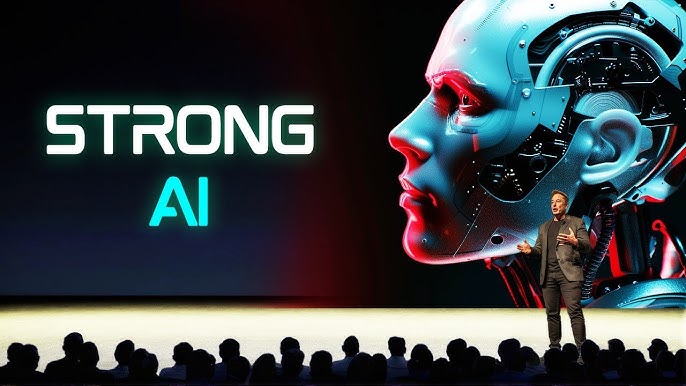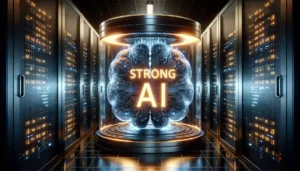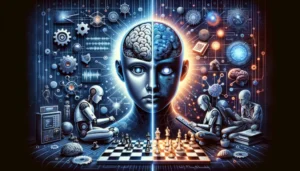What is Strong AI? Understanding the Vision of True Artificial Intelligence
Artificial Intelligence (AI) has rapidly transformed industries, from healthcare and finance to entertainment and education. But most of the AI we interact with today—voice assistants, chatbots, recommendation systems—is categorized as narrow AI. These systems excel at specialized tasks but lack the ability to think, reason, and adapt across multiple domains like humans do.
Enter the concept of Strong AI. Sometimes called Artificial General Intelligence (AGI), strong AI represents a form of intelligence that can understand, learn, and apply knowledge in a truly human-like way. It’s one of the most ambitious and debated goals in technology. But what exactly is strong AI, how does it differ from weak AI, and why does it matter for our future?
In this article, we’ll explore the meaning of strong AI, its origins, how researchers envision building it, its potential applications, and the ethical challenges it poses.
Defining Strong AI
Strong AI refers to artificial intelligence systems that possess generalized cognitive abilities comparable to human intelligence. Unlike weak AI, which is designed for specific tasks, strong AI would be able to:
-
Reason logically across different domains.
-
Learn and adapt without constant retraining.
-
Understand natural language in context, not just statistically.
-
Exhibit consciousness or self-awareness (in some definitions).
-
Transfer knowledge from one area to another, as humans do.
In other words, strong AI wouldn’t just simulate intelligence—it would possess it in a meaningful sense. Philosophers like John Searle introduced the distinction in the 1980s to separate practical AI applications from the pursuit of machine minds with true understanding.
Strong AI vs. Weak AI
To better understand strong AI, let’s contrast it with the AI we use every day:
| Aspect | Weak AI (Narrow AI) | Strong AI (AGI) |
|---|---|---|
| Scope | Task-specific (e.g., chess, translation, recommendations) | General-purpose intelligence across domains |
| Learning ability | Learns from data but within a fixed framework | Can learn and adapt across varied contexts |
| Understanding | Simulates understanding via algorithms | Possesses genuine comprehension |
| Flexibility | Cannot easily transfer knowledge between tasks | Transfers learning like humans |
| Examples | ChatGPT, Siri, Google Maps, Netflix suggestions | (Hypothetical) A machine that can think and reason like a human |
Most current AI breakthroughs—like GPT-5, MidJourney, or self-driving car AI—are still in the weak AI category. They may appear human-like but are domain-limited and lack generalized reasoning.
Historical Roots of Strong AI
The pursuit of strong AI is not new.
-
1950 – Alan Turing: Proposed the famous Turing Test to measure machine intelligence, asking whether a computer’s responses could be indistinguishable from a human’s.
-
1960s – Early optimism: Researchers at MIT and Stanford believed human-level AI was only decades away.
-
1980s – Strong vs. Weak AI Debate: John Searle’s “Chinese Room” argument challenged the idea that symbol manipulation equals true understanding.
-
2000s onward – Machine learning boom: The rise of deep learning renewed hopes of eventually reaching AGI.
The dream of strong AI has fueled decades of innovation, even though we’re not there yet.
Core Characteristics of Strong AI
For an AI system to qualify as “strong,” it must demonstrate abilities far beyond today’s narrow systems. These include:
-
Autonomy – It can make independent decisions without human guidance.
-
Generalization – It can apply knowledge from one problem to a completely different one.
-
Abstract reasoning – It can handle logic, mathematics, and philosophical questions.
-
Creativity – It can generate novel ideas, not just recombine existing data.
-
Self-awareness – In advanced definitions, strong AI would understand its own existence.
While some experts argue strong AI doesn’t need “consciousness,” others believe that without it, machines can never truly replicate human cognition.
Theoretical Approaches to Building Strong AI
Researchers propose several pathways to achieving strong AI:
1. Cognitive Architecture Models
These attempt to replicate the structure of the human brain. Examples include:
-
SOAR – A general problem-solving framework.
-
ACT-R – A model simulating human cognition processes.
2. Brain Simulation
Some believe mapping and simulating the human brain neuron by neuron could unlock strong AI. Projects like the Human Brain Project and advances in neuromorphic computing explore this path.
3. Evolutionary Algorithms
Here, AI evolves through natural selection–like processes, developing problem-solving skills across generations.
4. Hybrid AI Systems
A mix of symbolic AI (logic-based) and machine learning (data-driven) might provide the balance of reasoning and adaptability required.
5. Quantum AI
Quantum computing could provide the processing power necessary for human-level reasoning, although this remains speculative.
Potential Applications of Strong AI
If realized, strong AI would revolutionize nearly every aspect of human life:
-
Healthcare – AI doctors capable of diagnosing rare diseases, personalizing treatments, and even performing advanced surgeries.
-
Education – AI tutors providing human-level guidance and adaptive learning for every student.
-
Business & Economy – Decision-making AI capable of running entire corporations with optimized efficiency.
-
Science & Research – Machines generating new scientific theories, solving unsolved physics or biology problems.
-
Creative Arts – AI producing original music, literature, and film indistinguishable from human creations.
-
Space Exploration – Autonomous AI astronauts capable of exploring distant planets without human oversight.
Challenges and Criticisms
1. Technological Challenges
-
Lack of understanding of consciousness.
-
Limitations of current machine learning models (brittleness, hallucinations).
-
Massive computing requirements.
2. Ethical Challenges
-
Job displacement: Strong AI could automate intellectual work as easily as physical labor.
-
Control problem: How do we ensure a superintelligent AI aligns with human values?
-
Bias and fairness: Strong AI trained on biased data could magnify inequalities.
-
Existential risks: Thinkers like Nick Bostrom warn about scenarios where AGI surpasses human control.
3. Philosophical Challenges
-
Can machines ever truly “understand,” or are they just advanced pattern recognizers?
-
Should AI have rights if it becomes self-aware?
Current Status: Are We Close to Strong AI?
Despite rapid progress, we are not yet close to true strong AI. Current systems like GPT-5, Google DeepMind’s Gemini, or Anthropic’s Claude demonstrate impressive reasoning and creativity, but they:
-
Lack genuine understanding.
-
Struggle with long-term memory and planning.
-
Cannot independently transfer learning across radically different contexts.
Some experts predict AGI could emerge by 2040–2060, while others believe it may never be possible. Optimists argue scaling current models may eventually bridge the gap; skeptics believe fundamentally new approaches are required.
Strong AI in Popular Culture
Strong AI has captured the public imagination in science fiction:
-
HAL 9000 (2001: A Space Odyssey) – An intelligent but dangerous AI.
-
Data (Star Trek) – A self-aware android with human-like emotions.
-
Ava (Ex Machina) – A machine passing the Turing Test through manipulation.
-
Jarvis (Iron Man) – An AI assistant with personality and adaptability.
These portrayals raise both excitement and concern about living with truly intelligent machines.
The Road Ahead: Toward Responsible Strong AI
If humanity does achieve strong AI, it must be developed responsibly:
-
Ethical frameworks: International AI governance is essential to ensure safe deployment.
-
Transparency: AI decision-making must remain interpretable.
-
Human-centered design: Strong AI should augment, not replace, human intelligence.
-
Safety research: Initiatives like the Alignment Problem focus on ensuring AI goals align with human values.
The question is not just “can we build strong AI?” but also “should we, and under what conditions?”
Conclusion
Strong AI represents the holy grail of artificial intelligence research: a system capable of human-level reasoning, learning, and understanding across all domains. While weak AI dominates today’s landscape—powering shopping apps, self-driving cars, and chatbots—strong AI remains largely theoretical.
Its potential is staggering: breakthroughs in science, healthcare, education, and more. Yet its risks are equally immense: loss of jobs, ethical dilemmas, and even existential threats.
For now, strong AI remains a vision of the future—an ambitious dream that continues to inspire researchers, innovators, and philosophers. Whether it becomes reality will depend on both technological progress and humanity’s ability to guide it responsibly.
Apple’s AI Updates: How “Apple Intelligence” Is Reshaping the iPhone, iPad, Mac—and Beyond






